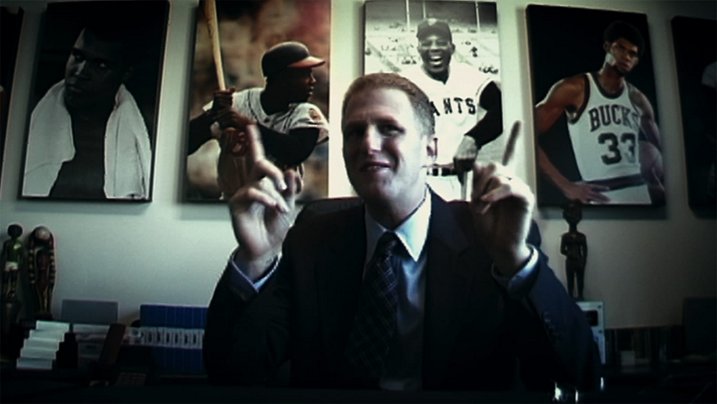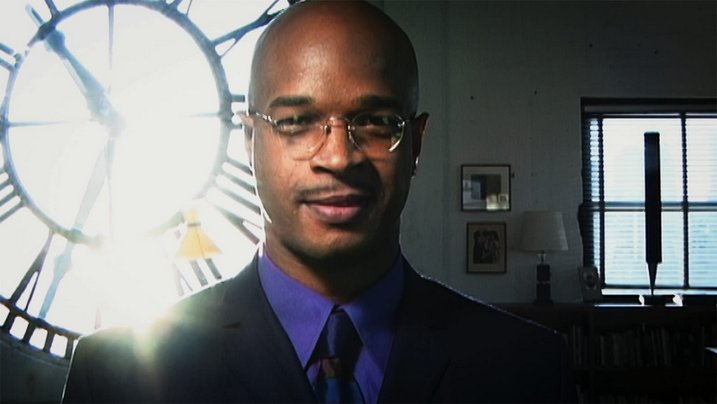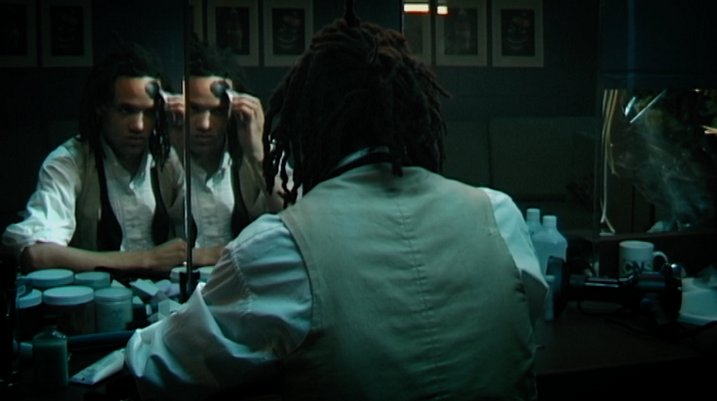Bamboozled – The Criterion Collection (Blu-ray Review)
 If ever there was a movie ready for re-examination, it’s Spike Lee’s Bamboozled. A theatrical bomb with audiences, and the recipient of mixed reviews from critics, there’s no denying a lack of ambition on Lee’s part with a film satirizing racism in American pop culture, but was the film ahead of its time or a misguided way to tackle the system? Lee has a way of taking big swings and landing them every so often. Perhaps The Criterion Collection putting out this film now is a way of showing audiences what Lee was up to back in 2000, showing just how tapped into the continued issues of the day he was aware of. Of course, being aware of certain problems doesn’t mean putting them on display automatically makes the film great. Still, it’s hard to ever say Lee isn’t trying.
If ever there was a movie ready for re-examination, it’s Spike Lee’s Bamboozled. A theatrical bomb with audiences, and the recipient of mixed reviews from critics, there’s no denying a lack of ambition on Lee’s part with a film satirizing racism in American pop culture, but was the film ahead of its time or a misguided way to tackle the system? Lee has a way of taking big swings and landing them every so often. Perhaps The Criterion Collection putting out this film now is a way of showing audiences what Lee was up to back in 2000, showing just how tapped into the continued issues of the day he was aware of. Of course, being aware of certain problems doesn’t mean putting them on display automatically makes the film great. Still, it’s hard to ever say Lee isn’t trying.
Film: 




Bamboozled stars Damon Wayans as Pierre Delacroix, a Harvard-educated black TV executive who has been taking a lot of criticism from his boss, Thomas Dunwitty (Michael Rapaport), for creating shows with black casts that are “too white” for audiences. To mix things up, Delecroix recruits two street performers, Womack (Tommy Davidson) and Manray (tap dancer Savion Glover), to headline a new series – Mantan: The New Millenium Minstrel Show.
The idea is to bring back blackface, ideally showing audiences and executives how much they should not want what they supposedly claim to see and the inherent exploitation arriving with these choices. The plan backfires, however, as audiences love it, and Delacroix becomes highly respected, creating more issues for many involved, and others observing from the outside.
Also featured in the cast is Jada Pinkett Smith as Delacroix’s assistant, Mos Def has her brother, Paul Mooney as a stand-up comedian and Delacroix’s father, Thomas Jefferson Byrd as an MC for the show, and The Roots as the show’s house band, “The Alabama Porch Monkeys.” Yes, this is supposed to come off as offensive, and it’s as uncomfortable to type as it can be to watch. However, it is all a part of Lee’s point in making this film.
Further blurring the lines of what comes off as ugly versus profound is the film’s look. The most notable element of Bamboozled was the stylistic choice to shoot much of the movie on Mini DV digital video cameras. The result is an unvarnished look that, even on Blu-ray, has a raw look, almost equivalent to a home movie. Part of the reasoning for this was to keep the budget down, but it also speaks to the effect of Lee shooting the ‘Minstrel Show’ sequences on Super 16. As a result, the most offensive parts of the film also look the best from a cinematic perspective.
So, what does it all add up to? It’s complicated. On the one hand, you have a new millennium version of Network, to a point (The Producers or A Face in the Crowd is also a good starting point to think on). The film is operating from a satirical point of view, intending to provoke the audience. Looking at it now, in 2020, it is easy to see what Lee is aiming out and how he’s worked to better confront some of these ideas in his more recent features, such as the Oscar-winning BlacKkKlansman. Given how strong a documentarian he is, I would also be curious about what he could do in taking on this subject from that perspective. As it stands, Bamboozled works best in its smaller moments.
Minor observations about life and racially-based microaggressions stand out. Watching the whole sequence involving the application of blackface makeup is heartbreaking. Seeing the changes in attitude towards what’s being accomplished is important to the film’s character arcs. Watching the extremes this film goes to feels less powerful, yet a lengthy montage at the end brings it all together.
Not unlike many of Lee’s films, at 136 minutes, Bamboozled feels messy at times, with a tendency to raise issues and handle them appropriately at first, only to keep nailing some of the same points. Some of this comes down the effort to get the most out of the talented performers and crew, which is understandable. Lee has Savion Glover and Paul Mooney, among others, so why not give them plenty of room to shine. At the same time, there’s only so much to accomplish, when the end goal seems so clear from the jump.
The other thing is how broadly the film wants to play its choices, and I’m sadly speaking mostly to Wayans’ lead performance. With such a specific accent choice (basically whiter than the whitest person), let alone other elements about his character, I could never get behind what Lee wanted to do with him enough to embrace the film more, no matter how much humor he derives from such a character (one who is often in the wrong, no less). Were Bamboozled to take the perspective of Davidson and Glover, or even Smith (all of whom are excellent in the film), I could see a better movie coming out of this overall.
This in mind, I’m not putting down the film as a whole. There’s too much good in it. I find the cinematography to be fascinating, the ideas and questions being raised worth examining, and the seemingly universal relevance of said questions to be unfortunately entirely appropriate to keep bringing up. Add to that a fantastic soundtrack that blends contemporary R&B, hip-hop, and the jazziness of composer Terence Blanchard, and you have another Lee project with too much to offer to be passed up.
It’s been a long-time since I had a chance to watch Bamboozled in full, and perhaps it will grow on me in the years to come. As it stands, there’s enough good in here to praise, but it comes with a handful of issues that are worth pointing out. At the same time, I’d much prefer a challenging film such as this to pretty much anything else. Fortunately, Lee has only grown in ability, and he already started out with plenty of it.
Video: 




Encoding: MPEG-4 AVC
Resolution: 1080p
Aspect Ratio: 1.77:1
Details: Bamboozled features a new digital master that was created in 2K resolution from the original SD PAL DV footage and new scans of the original Super 16 mm film footage and approved by director Spike Lee.
Clarity/Detail: This is such a tricky area to judge, as the film looks as good as it can, but one still has to deal with its limitations from a cinematography standpoint, intentional or not. That said, between the restoration to make the Mini DV camera work and just how terrific the Super 16 footage looks, it is hard to argue this is a bad transfer. It’s merely a product of what was created, and in that respect, there’s a lot to admire in how strong the film is in presenting the level of detail that’s allowed in this instance.
Depth: I’m beginning to realize how effective the film is on a visual level because of how much praise I have for the clarity of the picture when depicting the Minstrel Show. The level of depth involved speaks well to the transfer as well in these moments, as you can get a great sense of spacing thanks to the dance routines on display.
Black Levels: The black levels are excellent. Watching the performers apply the blackface makeup is both the most emotional point of the film, as well as one that shines as far as showing the black level quality here. If there’s a level of softness to note, it comes from the cameras involved in shooting the film.
Color Reproduction: Another area where there’s a clear divide in the different cameras used for the film. Colors pop in moments designed for them to do so. Otherwise, that softness can only allow this aspect to shine so brightly. Still, the deliberate nature of the photography means the harshness of certain areas makes an intended difference.
Flesh Tones: The detail level seen in the actual characters is impressive,
Noise/Artifacts: The film has been cleaned up, regardless of what comes from the way it was shot.
Audio: 




Audio Format(s): English DTS-HD Master Audio 5.1
Subtitles: English SDH
Details: The original 5.1 surround soundtrack was remastered from the 35 mm magnetic track using Avid’s Pro Tools and iZotope RX.
Dynamics: There’s a lot to enjoy about this mix, as the presentation is strong enough to deliver on the film’s essential music choices, which often overlaps with the dialogue. It’s all very effective in delivering on a quality audio track.
Low-Frequency Extension: The subwoofer gets to play in a few moments thanks to the use of musical numbers, and some events coming out of the film’s finale.
Surround Sound Presentation: Strong and center-focused, but enough is going on in the sound design to apply the supporting channels when needed.
Dialogue Reproduction: Everyone is heard loud and clear.
Extras: 





I can only imagine many were very excited to talk more about a film that was initially dismissed because there’s a lot to get into. Along with the many features that came with the original New Line Platinum Edition release, several new interviews are very worthwhile, along with the film’s original commentary track.
Features Include:
- Audio Commentary with Director Spike Lee – Recorded in 2001, with Lee giving you his truths about the making of the film, what he was going for at the time, and plenty more, offered in the always fun voice of Lee’s.
- In Conversation: Spike Lee with Ashley Clark (HD, 25:41) – A new conversation between Lee and Clark, who discuss where the film came from, what it meant, and what it means now. Very worth watching.
- Manray & Womack (HD, 22:54) – A conversation with Tommy Davidson and Savion Glover, who both have a lot to say about what they felt the film meant, and why it’s important to look at.
- Ruth E. Carter (HD, 10:21) – Oscar-winning costume designer Carter discusses her thoughts on the film and what she felt she was able to bring to the film.
- On Blackface and the Minstrel Show (HD, 17:34) – A focus on how the use of blackface has played a role in media, and what this movie did to put a spotlight on it, featuring media scholar Racquel Gates.
- The Making of Bamboozled (SD, 53:20) – A holdover from the original DVD release, which features interviews with the cast and crew from back during the film’s production.
- Deleted Scenes (17:04)
- Music Videos and Commercials (18:38) – Including Mau Maus’ “Blak Iz Blak” and Gerald Levert’s “Dream with No Love.”
- Poster Gallery (HD)
- Trailer (HD, 2:26)
- PLUS – An essay by critic Ashley Clark
Summary: 




It’s interesting to thin Lee had this and The Original Kings of Comedy arrive in theaters in the span of a few months. His documentary was the bigger hit, and it’s easy to see why. The film finds comedians doing what they do best while exploring the social elements of the world in a way anyone can laugh along with (and ideally think about later). Bamboozled does more to really hit audiences in the face with challenging messages, and a specific look that certainly seems untraditional. Reexamining the feature now, it’s easy to see why it would be hard for many to connect with, but it doesn’t mean it should be overlooked. Thanks to Criterion, there’s a lot to dig into as far as looking at the film again, and seeing the numerous extras that delve even further into what was behind an ambitious project such as this. That should be reason enough to check out this Blu-ray.
Order Your Copy Here:




































